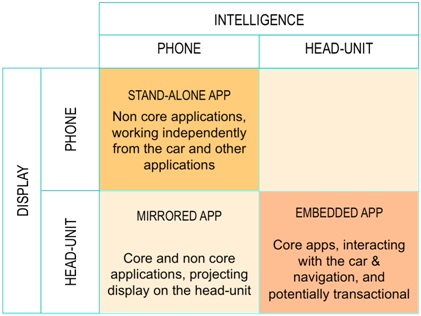NAVX on "Monetizing the in-car content-A focus on quality and global coverage"
For a content aggregator willing to cover all automotive segments (low cost, middle range, premium), it is important to be present on all solutions. It requires however to be creative in terms of business models and relationship with car makers.
Jean Cherbonnier, CEO & co-founder | NAVX
NAVX is a cloud-based content provider dedicated to connected cars, with a current focus on smart mobility applications (fuel prices, parking information and electrical vehicle POI). Through a proprietary platform, NAVX delivers real-time data to end-users, accessing the data set through in-dash applications or through mobile devices.
NAVX provides gas station data and fuel prices in 30 countries, parking information in 40 countries and electric points of charge information in 12 countries. To produce and deliver the information, we rely on more than 200 sources. Our clients are the car makers and OEM which provide connected solutions to their customers.
From our experience, being a supplier of content for the Automotive Industry requires the right tools and processes, combined with efficient and lean operations, to produce automotive-grade content through the processing of hundreds of different data feeds.
As a content aggregator, we move in a complex environment. In Europe for instance, we deal with 27 countries, 23 languages, 12 currencies, different legal systems, very fragmented data availability. Still, in the end, we provide our clients with one API, one high standard of quality, one Service Level Agreement.
Becoming a supplier of content for the Automotive industry requires 3 key elements:
- a global coverage, to provide content in all countries requested by car makers
- an efficient content management system, able to process data and measure KPIs in real time
- a reliable team of content analysts, specialists of each content category, to monitor quality and constantly identify and integrate new sources of information
Delivering content to the car driver: 3 solutions
There are three ways for a car driver to receive connected and relevant content on the road.
- Stand-alone app: the driver may use a stand-alone mobile application on its phone, with no connection whatsoever to the car itself. In that case, the car does not provide any connectivity nor any intelligence. For car makers, it’s a transparent solution: it does not cost them anything, and it brings them little value.
- Mirrored app: the driver may use a mobile application that is mirrored on the car’s head-unit. The phone is typically connected to the car through a wire or wireless connection. Here, connectivity and intelligence are still provided by the phone, but the car’s head-unit allows for a more user-friendly interface on a bigger screen, and possibly smart restriction of use to prevent distraction. For car makers, it’s a cheap solution: it only requires a dumb head-unit, and it is future proof since the evolution of the application will simply consists in application updates.
- Embedded app: the car may be equipped with a connected head-unit, that accesses content over-the-air through an embedded SIM card or through the drivers’ phone. The intelligence resides in the car, allowing the application to access specific contextual information (speed, tank level, engine parameters, sensors, etc), to benefit from the user-friendly interface on a big screen, and to potential interact with other on-board applications (i.e. navigation, traffic, etc). For the car maker, it’s the most expensive but also the most rewarding solution.
For a content aggregator willing to cover all automotive segments (low cost, middle range, premium), it is important to be present on all solutions. It requires however to be creative in terms of business models and relationship with car makers, as we will see below.
Who will own the customer ?
Before moving to the question of business models, we need to step aside and consider the current debate about the future of in-car infotainment solutions. Is the car an accessory to the phone, as Apple seems to pretend ? or is it doomed to become an auto piloted Android-powered device as Google seems to believe ? or will traditional car makers maintain their power over the industry ?
While development cycles in the automotive industry are traditionally measured in years, smartphones and tablets evolve at a much faster pace. Embedded systems risk becoming obsolete in a few months compared to the powerful smartphones car drivers have.
This is why smartphone-based solutions such as Mirrorlink, Google’s Android Auto and Apple’s Carplay are attracting interest. These solutions are supposed to make it easy for phones to connect to a dumb head-unit, and relieve car manufacturers from installing complex and costly connected systems. However, this will come at a cost: by letting outsiders leverage smartphone connectivity and applications, car makers risk giving up a potentially differentiating user experience and limit their access to customer data.
A safer route for car makers could be to follow the example of Tesla. A powerful infotainment systems embedded in the car, connected to the vehicle’s internal system and multiple sensors as well as to the cloud, would allow car makers to keep the « ownership” of the customer, differentiate from competitors and collect usage data. Over-the-air upgrades would make sure the embedded systems does not become obsolete too fast. This strategy requires car makers to transform themselves to look more like a software company than a steel-and-wheel company.
Monetizing content
In this context, content aggregator need to consider the three solutions (stand-alone phone app, mirrored app, embedded add) and build appropriate business models and relationships with car makers.
For a content aggregator, publishing a pure mobile application requires significant marketing efforts and a B2C business model. Indeed, being visible on a crowded application store and getting users to pay are two serious challenges. Only with a large audience can the application be monetized through advertising and couponing.
Operating a mirrored application allows to build a stronger partnership with car manufacturers. There still is a need to fight for visibility within the application stores. But in this case, collaborating with the car maker may boost revenues and visibility. First, the content aggregator may release its application as a freemium service, whereby in-app purchase is required to access more services, including mirroring and other car-specific functionalities. Secondly, co-branding the application with the car maker would boost its visibility, and would encourage the car maker to dedicate significant efforts to promote the application outside the application store.
With the embedded model, the content aggregator and the car manufacturer are working closely. In terms of user experience, the content can be presented with contextual relevance based on the other apps embedded in the vehicle. For instance, a cheap fuel station is selected automatically based on the tank level and the destination, a parking lot is proposed based on destination and traffic conditions, etc. Transactional functionality can be added, such as booking a parking spot or an EV charging station directly from the in-car head-unit.
It opens possibilities for various business models, from traditional licensing fees per car, to subscription-based fees paid by the end-user to revenue-sharing with car makers on coupons or booking fees.
Conclusion
The Automotive industry is at a crossroad. Data and software will rapidly become critical elements in the vehicle’s value, and collecting data from cars will be essential to develop loyalty, derive new sources of revenues, and optimize maintenance costs. In this context, new entrants such as Tesla and Google seriously challenge traditional players.
We think car makers should seize this opportunity to introduce new services and business models, and rely on big content aggregators to help them differentiate with better content.
About the author
Jean Cherbonnier, CEO & co-founder | NAVX
Jean has worked for IBM, Texas instruments and Arthur D. Little, before co-founding K-Mobile in 1999, a leading provider of content for mobile phones. After the acquisition of K-Mobile by AG Interactive in 2004, Jean cofounded NAVX, a cloud-based content provider for connected cars, delivering near real-time data, such as fuel prices, parking information, EV points of charge.



